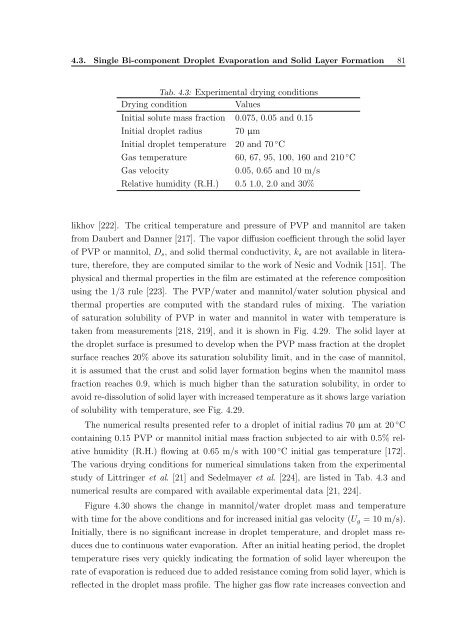INAUGURAL–DISSERTATION zur Erlangung der Doktorwürde der ...
INAUGURAL–DISSERTATION zur Erlangung der Doktorwürde der ...
INAUGURAL–DISSERTATION zur Erlangung der Doktorwürde der ...
Create successful ePaper yourself
Turn your PDF publications into a flip-book with our unique Google optimized e-Paper software.
4.3. Single Bi-component Droplet Evaporation and Solid Layer Formation 81<br />
Tab. 4.3: Experimental drying conditions<br />
Drying condition<br />
Values<br />
Initial solute mass fraction 0.075, 0.05 and 0.15<br />
Initial droplet radius 70 µm<br />
Initial droplet temperature<br />
Gas temperature<br />
Gas velocity<br />
20 and 70 ◦ C<br />
60, 67, 95, 100, 160 and 210 ◦ C<br />
0.05, 0.65 and 10 m/s<br />
Relative humidity (R.H.) 0.5 1.0, 2.0 and 30%<br />
likhov [222]. The critical temperature and pressure of PVP and mannitol are taken<br />
from Daubert and Danner [217]. The vapor diffusion coefficient through the solid layer<br />
of PVP or mannitol, D s , and solid thermal conductivity, k s are not available in literature,<br />
therefore, they are computed similar to the work of Nesic and Vodnik [151]. The<br />
physical and thermal properties in the film are estimated at the reference composition<br />
using the 1/3 rule [223]. The PVP/water and mannitol/water solution physical and<br />
thermal properties are computed with the standard rules of mixing. The variation<br />
of saturation solubility of PVP in water and mannitol in water with temperature is<br />
taken from measurements [218, 219], and it is shown in Fig. 4.29. The solid layer at<br />
the droplet surface is presumed to develop when the PVP mass fraction at the droplet<br />
surface reaches 20% above its saturation solubility limit, and in the case of mannitol,<br />
it is assumed that the crust and solid layer formation begins when the mannitol mass<br />
fraction reaches 0.9, which is much higher than the saturation solubility, in or<strong>der</strong> to<br />
avoid re-dissolution of solid layer with increased temperature as it shows large variation<br />
of solubility with temperature, see Fig. 4.29.<br />
The numerical results presented refer to a droplet of initial radius 70 µm at 20 ◦ C<br />
containing 0.15 PVP or mannitol initial mass fraction subjected to air with 0.5% relative<br />
humidity (R.H.) flowing at 0.65 m/s with 100 ◦ C initial gas temperature [172].<br />
The various drying conditions for numerical simulations taken from the experimental<br />
study of Littringer et al. [21] and Sedelmayer et al. [224], are listed in Tab. 4.3 and<br />
numerical results are compared with available experimental data [21, 224].<br />
Figure 4.30 shows the change in mannitol/water droplet mass and temperature<br />
with time for the above conditions and for increased initial gas velocity (U g = 10 m/s).<br />
Initially, there is no significant increase in droplet temperature, and droplet mass reduces<br />
due to continuous water evaporation. After an initial heating period, the droplet<br />
temperature rises very quickly indicating the formation of solid layer whereupon the<br />
rate of evaporation is reduced due to added resistance coming from solid layer, which is<br />
reflected in the droplet mass profile. The higher gas flow rate increases convection and













